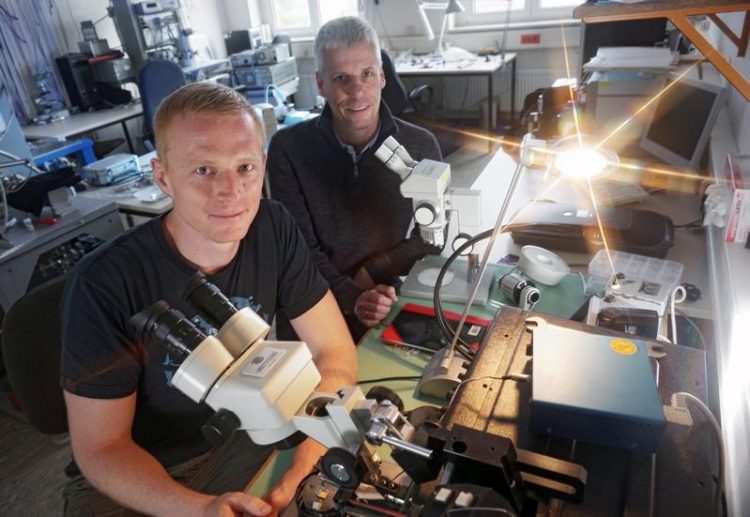Three kinds of information from a single X-ray measurement

The physicists Dr Andreas Johannes (l.) and Prof. Dr Carsten Ronning in a laboratory at the Institute of Solid State Physics of Friedrich Schiller University Jena. Photo: Jan-Peter Kasper/FSU Jena
Whatever the size of mobile phones or computers are, the way in which such electronic devices operate relies on the interaction between various materials. For this reason, engineers as well as researchers need to know exactly how specific chemical elements inside a computer chip or a transistor diode behave, and what happens when these elements bond.
Physicists of Friedrich Schiller University Jena, Germany, have now developed an innovative method that enables them to obtain several different types of information simultaneously from the interior of a nanoscale building block – and this while it is in the active state. The researchers from Jena and their partners have reported their findings in the current issue of the specialist journal “Science Advances”.
“Using our method, we can obtain information at one and the same time about the elements’ composition, that is to say the fraction between the elements; about their oxidation grade, which means their valence state or the nature of the bond; and finally about internal electrical fields that have thus been created,” explains Prof. Dr Carsten Ronning of the University of Jena.
“These are all elementary indicators for the component’s function,” adds Ronning, who heads the project. However, in the procedure developed by the physicists from Jena, together with colleagues from Grenoble, Madrid and Vienna, the components to be investigated do not have to be elaborately prepared or possibly even destroyed. “In principle, we can X-ray the diodes of a mobile phone while it is switched on, without damaging it,” says Ronning.
X-ray beam from the particle accelerator
A decisive feature of the research approach is a very finely focussed X-ray beam, with which the Jena physicists initially X-rayed a device specially made for their experiments. “We introduced arsenic and gallium atoms into a silicon wire around 200 nanometres thick. When heated, these atoms agglomerate at one point, that is to say they mass together, which produces a functional component,” explains Prof. Ronning. “We then ran a 50-nanometre-wide X-ray beam along the wire, thus irradiating it bit by bit.”
The researchers established that – such as in a solar cell – this arrangement mixture of materials converted the X-rays into electric current, which flowed only in one direction, as in a diode. In this way, the researchers made the internal electrical fields visible that are essential for the function of the component. In addition, the component emitted light.
“The X-rays excite the atoms in the building block, which emit a characteristic radiation,” explains Dr Andreas Johannes, who conducted the experiments. “In this way we obtain a spectrum, which gives us valuable information about the individual elements present and their relative ratios.” If the energy of the X-rays is altered, so called X-ray absorption spectra are produced that enable researchers to make assertions regarding the oxidation grade of the elements – and by extension regarding the bonds themselves.
Obtain all these types of information through one measurement
“Now, it is possible to obtain all these types of information through one measurement by using our method,” says Andreas Johannes. Although comparable results are possible using electron microscopy, in these cases the devices have to be specially prepared and possibly destroyed, as the penetration depth of the electron beam is substantially more limited. Moreover, such measurements can only take place in a vacuum, whereas the X-ray method is virtually independent of any specific environment.
Up to now, such narrow X-ray beams can only be generated by particle accelerators, which is why the Jena University physicists have been working together closely with the European Synchrotron Radiation Facility (ESRF) in Grenoble, France, to develop the new measuring method. These facilities are available to both, scientific researchers and industry, in order to X-ray existing components with greater precision and, above all, to try out new combinations of materials in order to create better performing components.
“For example, our method can be of value in developing new batteries,” says Andreas Johannes. “Because researchers would also like to examine these, especially while in use and fully operational, for example to determine the oxidation grades of the elements.”
Original publication:
Andreas Johannes et al.: In-operando X-ray imaging of nanoscale devices: composition, valence, and internal electrical fields, Science Advances 2017, DOI: 10.1126/sciadv.aao4044
Contact:
Prof. Dr Carsten Ronning
Institute of Solid State Physics of Friedrich Schiller University Jena
Helmholtzweg 3, 07743 Jena, Germany
Phone: +49 (0)3641 / 947300
Email: carsten.ronning[at]uni-jena.de
Media Contact
All latest news from the category: Physics and Astronomy
This area deals with the fundamental laws and building blocks of nature and how they interact, the properties and the behavior of matter, and research into space and time and their structures.
innovations-report provides in-depth reports and articles on subjects such as astrophysics, laser technologies, nuclear, quantum, particle and solid-state physics, nanotechnologies, planetary research and findings (Mars, Venus) and developments related to the Hubble Telescope.
Newest articles

Combatting disruptive ‘noise’ in quantum communication
In a significant milestone for quantum communication technology, an experiment has demonstrated how networks can be leveraged to combat disruptive ‘noise’ in quantum communications. The international effort led by researchers…

Stretchable quantum dot display
Intrinsically stretchable quantum dot-based light-emitting diodes achieved record-breaking performance. A team of South Korean scientists led by Professor KIM Dae-Hyeong of the Center for Nanoparticle Research within the Institute for…

Internet can achieve quantum speed with light saved as sound
Researchers at the University of Copenhagen’s Niels Bohr Institute have developed a new way to create quantum memory: A small drum can store data sent with light in its sonic…





















